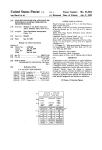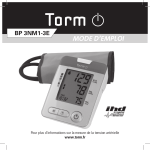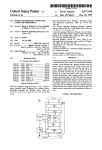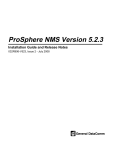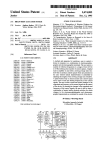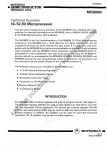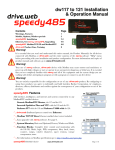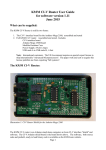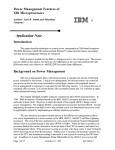Download Method and apparatus for control of power consumption in a
Transcript
USOO5655 127A United States Patent [19] [11] Patent Number: [45] Date of Patent: Rabe et al. [54] METHOD AND APPARATUS FOR CONTROL OF POWER CONSUIVIPTION IN A 0419908 0451661 COMPUTER SYSTEM 5,655,127 Aug. 5, 1997 6/1990 European Pat. 0ft. . 3/1991 European Pat. O?'. . (List continued on next page.) [75] Inventors: Jeifrey L. Rabe. Rancho Cordova; OTHER PUBLICATIONS Zohar Bogin. Folsom; Ajay V. Bhatt, _ “ ~ . _ El Dorado Hills; James R Kardach’ Slater, Michael, MIPS Prevzews 64-bit R4000 Archztec San Jose; Nilesh V_ Shah’ Folsom’ all of can. ture , Microprocessor Report, vol. 5, Issue: n2, p1(6), Feb. 6’ 1991' Case, Brian. “R4000 Extends R3000 Architecture With [73] Assignee: Intel Corporation, Santa Clara, Calif, 64-bit Capabilities”, Microprocessor Report, vol.: v5, Issue: n19, p10(4), Oct. 16, 1991. 2 l. N .: Wilson ~ Ron ’ “MIPS Rethinks RISC With SuP e'PP i elining” ’ 67 [ 1] App 0 612’ 3 [22] Filed: Mar. 8, 1996 Computer Design. V01: V30, Issue: n3, p28(3), Feb. 1, 1991. Intel Automotive Components Handbook, “Power-On Reset”, 1988, pp. 10-24 & 10-25. Motorola MC6802032—Bit Microprocessor User’s Manual, Related US. Application Data 3rd Edition, 1990, . 1-3. [63] [51] Continuation of Ser. No. 191,651, Feb. 4, 1994, abandoned. Int Cl 6 G06F 1,26 Pp Primary Examiner—-Glenn A. Auve [52] US. Cl. o .................. -----------------------------------------------------.. 395l750.04; 345/838; u Attorney’ Agent) or Firm_B1ake1y, K. sokolo?-‘q Taylor & [58] Field of Search ................................... .. 395/750, 838, Zafman , [56] A computer system having a responsive low-power mode References Clted U_S_ PATENT DOCUMENTS and a full-power mode of operation. The computer system includes a power consumption controller, a processor and a communication device. The power consumption controller 3,623,017 11/1971 Lowell et a1. . generates an interrupt signal in response to a low power 3,715,729 2/ 1973 Mercy; 3,736,569 5/1973 130111161115 61111- - event or a fully operational event. The power consumption 3,737,637 6/1973 Frankeny et a1. 395/750 controller also generates a clock control signal. The clock 371/28 Conn-o1 signal is deassm-tcd during the fu]l_p0we1- mode of 3,395,311 7/1975 Bass? et 31- ~ 3’919’695 11/1975 G°°dmg ' 4’077’016 game; ct ala'l' 2/1978 82:56 2: a1‘ ' 4:095:267 6,1978 Modmoto _ ' ' operation and alternatively asserted for a ?rst duration and deasserted for a second duration during the low-power mode of operation. In response to an asserted clock control signal, the processor suppresses the internal clock signal to at least one functional block within the processor and in response to a deasserted clock control signal, the processor transmits the internal clock signal to at least one functional block within (List continued on next page.) the processor. By transmitting the internal clock signal to at least one functional block within the processor during the low-power mode of operation, the processor may respond to cormnunication signals from a communication device dur FOREIGN PATENT DOCUMENTS 0103755 0140814 8/1983 5/1984 0242010 12/1987 0368144 2/1989 0366250 9/1989 European Pat. European Pat. European Pat. European Pat. European Pat. Otf. O?'. O?‘. O?’. O?'. . . . . . ing the low-power mode of operation. 18 Claims, 9 Drawing Sheets POWENUP mocrssoi m lNNLLYOPERATlONALN?DE srirci runcnurut PARAMETERS | on SWll‘Qi YD LOW vowen \WCE Ev serum; umurnm: ENABLE 5H5 on LCW zvrw v FA'l 1 not». - mPuv um stoma Flnsr SPEClFlED non/mm - mPurmn stun: srcom SFEClF ED rumor»: rum spa-mm nmwlon rxrlazu'l on WEAK EVENI? Y 5,655,127 Page 2 [LS RAJ'ENT DOCUMENTS 5,077,686 12/1991 Rubinstein. 5,083,266 1/1992 w616n6b6 .............................. .. 395/275 5,103,114 5,123,107 4/1992 1311611. 6/1992 Mensch, I12. 5,129,091 5,133,064 7/1992 Y611m616 6161.. 7/1992 1161166161.. 4,365,290 12/1982 Nelms et a1. 1 5,151,992 9/1992 Nagae, 4,405,898 5,167,024 11/1992 Smith 6161. .......................... .. 395/375 4,203,153 4,264,863 5/1980 Boyd4/1981 K9Jm_1_a- 4,293,927 10/1981 Hoshu4,300,019 11/1981 Toyomaki9/1983 Flemming- 4,479,191 10/1984 N6jim6 6161.. 4,545,030 10/1985 Kitchin4,615,005 9/1986 Maejima 9t a1~4,638,452 1/1987 Schultz et 61.. 4,639,864 1/1987 Katzman et a1-4,667,289 5/1987 Yoshida 9141-. 4,669,099 5/1987 Zinn. 4,698,748 10/1987 Juzswik 6161.. 4,758,945 7/1988 Remedi4,763,294 8/1988 F9119 5,175,845 1271992 11616. 5,189,647 2/1993 Suzuki 6161,. 5,220,672 6/1993 N6k66 6161.. 5,239,652 3/1993 $611,611 6161.. 5,249,298 9/1993 B01311 6: 61.. 5,251,320 10/1993 Kuzawinski 6161.. 5,263,028 11/1993 Borgnjs et 211.. 5,319,771 6/1994 Takeda, 5,329,621 7/1994 Burgess 6161.. 5,335,168 8/1994 w61k6r .................................. .. 364/707 4,766,597 8/1988 K616. 4,780,843 10/1988 Tietjen. 4,814,591 3/1989 Nara e1 41-- 5,336,939 8/1994 Eitrheim 6161.. 5,355,501 10/1994 616666161. 5,359,232 10/1994 Eitrheim 6161.. 4,823,292 4/1989 H?lwn- 4,841,440 611989 Yonezu et a1-- 5,369,771 5,396,635 4,881,205 11/1989 Aih6r6. 4,896,260 1/1990 Hyatt4,907,183 3/1990 Tanaka4,922,450 5/1990 126666161. 4,935,863 6/1990 Calvas er a1~~ 4,979,097 12/1990 Trioloet 61.. 11/1994 ................... .. 395/750 3/1995 Fung ..................................... .. 395/800 5,404,546 4/1995 s16w6n. 5,428,754 6/1995 Baldwin. 5,461,652 10/1995 HOngO. FOREIGN PATENT DOCUMENTS 4,980,836 12/1990 (2611616161. .......................... .. 364/483 0478132 12/1991 4,983,966 4,991,129 5,021,679 0654726 10/1994 1361616666 Pal. 011.. 9302408 2/1993 Germany, 2010551 11/1978 United Kingdom, 1/1991 Groneet 61.. 2/1991 SWal‘lZ. 6/1991 Fairbanks 6t 61.. 5,059,924 10/1991 Check. 1316616666 Pat. 011.. 2130765 10/1983 United Kingdom. US. Patent Aug. 5, 1997 105 1 ‘ POwER CONSUMPTION CONTROLLER Sheet 1 of 9 5,655,127 104 102 / ” MONITOR RAM 101 . 1/06 COMMUNICATIONS \ DEV'CE BUS 125 3 SMI# /LINE 151 103 PROCESSOR PIE / 1 104 102 / / MONITOR RAM 1/06 COMMUNICATIONS DEVICE \ BUS 125 POWER /103 CONSUMPTION CONT1%€LLER PROCESSOR US. Patent Aug. 5, 1997 Sheet 2 Of 9 5,655,127 POWER OFF POWER SWITCH 5—34 TURNED OFF POWER I l POWER SWITCH TURNED OFF SWITCH TURNED ON POWER ON FULLY OPERATIONAL MODE .522 LOW POWER EVENT COUNTER EXPIRES EXTSMI# REAL TIME CLOCK RUN SMM HANDLER HARD DISK SPUN UP CRT SCREEN AT NORMAL INTENSITY ASSERT SMI# 29. 51E RUN SMM HANDLER HARD DISK SPUN DOWN ORT SCREEN OFF OR AT LOW INTENSITY FULLY OPERATIONAL EvENT MOUSE KEYBOARD EXTSMI# §_2_g_ REAL TIME CLOCK RESPONSIVE LOW POWER MODE E PIH__3 US. Patent Aug. 5, 1997 Sheet 3 of 9 $21%5 23E%;: 6@2058 8$56%28 a.%. 5,655,127 $52m0:32985 iWlH-MI US. Patent Aug. 5, 1997 Sheet 4 0f 9 5,655,127 .IOm m9 EmwofmO2gE9owm 3 9th 520.65% % § E5ajo2zO g 51M2502 éa95z:gw Mm:25mum Em a 159E: mm mmw vmw min-HF! US. Patent Aug. 5, 1997 Sheet 5 Of 9 5,655,127 STPCLK# DEAssERTED (FULLY OPERAT'ONAL MODE) — LOW TIMER REGISTER LOADED WITH FIRsT SPECIFIED DuRATION E - LOW TIMER REsET — HIGH TIMER REGISTER LOADED WITH SECOND SPECIFIED DURATION _ HIGH TIMER REsET STPCLK# — DESIRED BREAK EvENT ENABLE ENABLE BIT BITs SET cLEARED - STPCLK# ENABLE BIT SET EXPIRATION OF HIGH TIMER 5TPCLK# AssERTED ‘ (RESPONSIVE LOW POWER MODE) BREAK SIGNAL EXPIRATION (BREAK EVENT WITH BIT ENABLED) OF LOW TIMER STPCLK# DEAssERTED (RESPONSIVE LOW POWER MODE) E4. BREAK SIGNAL (BREAK EvENT WITH BIT ENABLED) HIGH TIMER RESET L63. FII3_E US. Patent Aug. 5, 1997 mm‘ mm“ mm" “3 “2 “m3. ima 5% mm m3. 17 mmm1 Sheet 6 0f 9 5,655,127 US. Patent Aug. 5, 1997 Sheet 7 of 9 5,655,127 mew mmm: mew w1m+EAx mew mmm1 wfoncw 29530 @206 .mlhui US. Patent Aug. 5, 1997 5,655,127 Sheet 9 Of 9 FIE_EI @ POWER UP PROCESSOR IN FULLY OPERATIONAL MODE / 939 I SELECT FUNCTIONAL PARAMETERS FOR / 940 SWITCH TO LOw POWER MODE BY SETTING APPROPRIATE ENABLE BITS 941 LOW POWER EVENT SWITCH PROCESSOR TO LOW POWER MODE MODIFY FUNCTIONAL PARAMETERS FOR SWITCH TO FULLY OPERATIONAL MODE INPUT AND STORE FIRST SPECIFIED DURATION INPUT AND STORE SECOND SPECIFIED DURATION SET STPCLK# ENABLE BIT V 944 FIRST SPECIFIED DURATION EXPIRED? OR BREAK EVENT? 946 N SECOND SPECIFIED DURATION EXPIRED? N SUPPRESS CLOCK SIGNAL ALLOW CLOCK 947 / OPERATIONAL MODE EVENT? FULLY OPERATIONAL MODE EVENT? SWITCH PROCESSOR TO FULLY OPERATIONAL MODE —— MODIFY FUNCTIONAL PARAMETERS FOR SWITCH TO LOW POWER MODE — CLEAR STPCLK# ENABLE BIT I 5,655,127 1 2 METHOD AND APPARATUS FOR CONTROL OF POWER CONSUMPTION IN A COMPUTER SYSTEM for switching the computer system between a fully opera tional mode and a responsive low power mode. In addition, in one embodiment the power consumption controller can include a clock controller for cyclically suppressing a clock signal to a portion of a processor for a ?rst speci?ed duration This is a continuation of application Ser. No. 08/ 191,65 1, ?led Feb. 4. 1994, now abandoned. FIELD OF THE INVENTION when the computer system is in the responsive low power The present invention relates to the ?eld of computer systems. More particularly, the present invention relates to the control of power consumption in computer systems. 10 BACKGROUND OF THE INVENTION include a break event device for signaling the clock con troller to allow the clock signal to be transmitted to the portion of the processor for a second speci?ed duration. Finally, the power consumption controller can include a Existing computer systems consume large amounts of electrical power when operating in the fully operational mode. These systems typically lack power consumption controllers and thus when left idle. the systems continue to remain in the fully operational mode. The United States Environmental Protection Agency (EPA) has established guidelines encouraging the manufacture of computer sys tems which when left idle for an extended period only selection device for selecting functional parameters of the power consumption controller, which de?nes events causing switching between the modes. BRIEF DESCRIPTION OF THE DRAWINGS consume a speci?ed amount of electrical power or less. One prior power consumption controller was used in portable computer systems. The prior controller would turn off the monitor. spin down the hard disk and shut down the central processing unit (CPU). Because the prior controller mode. Under this embodiment, the clock controller also cyclically allows the clock signal to be transmitted to the portion of the processor for a second speci?ed duration when the computer system is in the responsive low power mode. Moreover, the power consumption controller can 25 shut down the CPU, the portable system could not be responsive to signals coming from a communications device. for instance, a network, fax machine or modern. The present invention is illustrated by way of example, and not by way of limitation, in the ?gures of the accom panying drawings and in which like reference numerals refer to similar elements and in which: FIG. 1 is a block diagram illustrating a computer system of one embodiment of the present invention. FIG. 2 is a block diagram illustrating a computer system with a processor incorporating the power consumption con troller. FIG. 3 is a state diagram illustrating the operation of a However. most portable systems were not connected to a communications device anyway and thus did not need to be responsive to signals from the communications device. Desktop computer systems on the other hand, usually are power consumption controller of FIG. 1. connected to a communications device and need to be FIG. 4 is a block diagram illustrating the power consump tion controller of FIG. 1. of the prior controller in a desktop system connected to a 35 FIG. 5 is a block diagram illustrating a clock controller of communications device causes the desktop system to fail to FIG. 4. respond to signals from the communications device after a FIG. 6 is a state diagram illustrating the operation of speci?ed idle period when the CPU is shut down. With the STPCLK# signal state machine of FIG. 5. network as a communications device. the network deacti responsive to signals from the communications device. Use vates the system address, in effect. removing the system from the network after the failure to respond. Other systems 40 FIG. 7a is a timing diagram illustrating the operation of a clock controller of FIG. 5. in the network becomes unable to communicate with the FIG. 7b is a timing diagram illustrating communication signals being transmitted from a communication device. FIG. 8 is a block diagram illustrating a switching device desktop system and the desktop system becomes unable to receive any information from the network. Similarly, with a fax machine or modern as the commu 45 of a seventh embodiment of the present invention. nications device connected to the desktop system.v the prior controller in the desktop system causes the desktop system FIG. 9 is a flow chart illustrating the steps for controlling the power consumption of a processor. to fail to respond to communications signals. In this case. the fax machine or modern ceases transmission of data and the desktop system fails to receive the data. It would be highly bene?cial to have a desktop computer system with a power consumption controller that switches the system between a fully operational mode and a respon sive low power mode, where the responsive low power mode still allows the system to be responsive to communi cations device signals. The system could then satisfy EPA guidelines by switching to the responsive low power mode after a speci?ed idle period, and respond to communications signals or process information from the communications device. Thus, what is needed is a power consumption controller that switches a computer system between a fully operational mode and a responsive low power mode. DETAILED DESCRIPTION 50 A power consumption controller and a method for con trolling power consumption is described. In the following description, the invention is described with reference to speci?c exemplary embodiments thereof. It will, however, 55 be evident that various modi?cations and changes may be made thereto without departing from the broader spirit and scope of the invention as set forth in the appended claims. The speci?cations and drawings are, accordingly, to be regarded in an illustrative rather than a restrictive sense. FIG. 1 is a block diagram illustrating a computer system of one embodiment of the present invention. The computer system includes hard disk drive 101, random access memory (RAM) 102, processor 103, monitor 104, power consump tion controller 105 and communications device 106. Hard SUMMARY OF THE INVENTION 65 disk drive 101 and monitor 104 are coupled to processor 103 A novel power consumption controller is described. The by bus 125. Processor 103 in turn is coupled to power power consumption controller comprises a switching device consumption controller 105 by line 151. It will be appreci 5,655,127 3 4 ated that power consumption controller 105 can be incor ?ed duration are set such that processor 103 can acknowl porated into other devices. FIG. 2 is a block diagram illustrating a computer system edge within the latency period. with a processor incorporating the power consumption con troller. In the system. power consumption controller 105 is built into processor 103. Processor 103 has the necessary circuitry and logic to carry out the functions of power sive low power mode until the power switch is turned off or a fully operational event occurs. When power switch is turned oif, controller 105 transitions to the power oif state Power consumption controller 105 remains in the respon where controller 105 along with the rest of the system is turned 01?, state 534. On the other hand, when a fully consumption controller 105. In addition, signals from power consumption controller 105 that would normally transmitted operational event occurs, controller 105 asserts a second SMI# signal, state 538. Fully operational events are events which cause the switch to the fully operational mode and like low power events are selectable by processor 103. Fully across line 151 to processor 103 now proceed directly to processor 103. FIG. 3 is a state diagram illustrating the operation of a power consumption controller of FIG. 1. When the system operational events can include movement of a mouse device, is ?rst turned on, the system transitions from the power off state 534 to the power on state 535 where the system is in input to a keyboard, the receipt of an external signal from a push button (EXTSMI#), and a signal from a real time clock the fully operational mode. Power consumption controller device indicating current time is the preset time for switch 105 remains in the fully operational mode until the power ing to fully operational mode. It will be appreciated that switch is turned off or a low power event occurs. When other events can also be selected as fully operational events. power switch is turned off, controller 105 transitions to the power off state where controller 105 along with the rest of the system is turned oif. On the other hand, when the power switch is not turned oif. power consumption controller 105 As described above, controller 105 responds to a fully operational event by asserting a second SMI# signal to processor 103, state 538. Processor 103 responds by running the SMM Handler software, state 529. SMM Handler includes code that processor 103 executes to instruct the Waits for a low power event Low power events are events hard disk to spin up and the monitor to turn on to normal which cause the switch to the responsive low power mode and are selectable at boot up of the system or by processor 25 intensity. Processor 103 then executes SMM Handler code to switch to the fully operational mode, state 535. In the fully 103. Low power events can include the expiration of elapsed operational mode, controller 105 no longer asserts the STP time as indicated by a counter, the receipt of an external CLK# signal and processor 103 remains fully operational. signal from a push button (EXTSMI#), and a signal from a Controller 105 operates in the fully operational mode as real time clock device indicating current time is the preset described above. time for switching to responsive low power mode. It will be appreciated that other events can also be selected as low FIG. 4 is a block diagram illustrating the power consump tion controller of FIG. 1. Power consumption controller 105 power events. Power consumption controller 105 responds to a low power event by asserting a SMI# signal to processor 103, state 536. Processor 103 responds by running software includes switching device 612 and clock controller 611. Switching device 612 is coupled to inputs from processor 35 mode button, real time clock or other similar devices. In addition, processor 103 also has inputs to clock controller 611. Switching device 612 switches the computer system between a fully operational mode and a responsive low power mode by asserting a SMI# signal. As described above, when the computer system is in the fully operational mode, an assertion of a SMI# signal switches the computer system to a responsive low power mode. On the other hand, when speci?ed duration and deasserts STPCLK# signal to proces sor 103 for a second speci?ed duration. While controller 105 remains in the responsive low power mode, it repeats the assertion and deassertion of STPCLK# signal in the manner described above. Processor 103 responds to the assertion of STPCLK# signal by suppressing the clock signal to a portion or all of processor 103. Processor 103 responds to the deassertion of STPCLK# signal by recoupling the clock 45 50 signal to the previously suppressed portion of processor 103. It will be appreciated that processor 103 is at least partially off for the ?rst speci?ed duration while STPCLK# signal is asserted and operating at full capacity for the second speci ?ed duration while STPCLK# signal is deasserted. Because processor 103 is at least partially off for the ?rst speci?ed duration in each cycle, power consumption is reduced. In addition, because processor 103 is operating at full capacity for the second speci?ed duration in each cycle, processor 103 is responsive to signals from communications device 103 and other devices in the computer system. The other devices can include a mouse device, keyboard. low power called SMM Handler as shown in state 528. SMM Handler includes code that processor 103 executes to instruct the hard disk to spin down and the monitor to turn off or reduce intensity. Processor 103 then executes the SMM Handler code to switch to the responsive low power mode, state 537 . In the responsive low power mode, controller 105 asserts an active low STPCLK# signal to processor 103 for a ?rst the computer system is in the responsive low power mode, an assertion of a SMI# signal switches the computer system to a fully operational mode. In this embodiment, switching device 612 asserts the SMI# signal to processor 103 using line 151. However, under an alternative embodiment, switching device 612 can also assert the SMI# signal to processor 103, clock controller 611 or to other devices in the computer system such as monitor 104 or hard disk drive 101. In addition, switching device 612 can assert the SMI# signal on bus 125 to a 55 separate device which asserts another SMI# signal directly to processor 103 on a dedicated line. When processor 103 receives the SMI# signal, it signals clock controller 611 to switch it to a responsive low power mode if it was previ ously in a fully operational mode; it signals clock controller 611 to switch it to a fully operational mode if it was 106 during the second speci?ed duration. Thus, it will be appreciated that processor 103 will be su?iciently respon previously in a responsive low power mode.'As described above, in the responsive low power mode, clock controller sive to remain on a network where the time between each 611 asserts STPCLK# signal to processor 103 for a ?rst network poll is greater than the ?rst speci?ed duration plus the second speci?ed duration. It will also be appreciated that speci?ed duration and deasserts STPCLK# signal to proces processor 103 will be su?iciently responsive to remain on a sor 103 for a second speci?ed duration. In the fully opera tional mode, clock controller 611 no longer asserts STP network where the ?rst speci?ed duration and second speci CLK# signal and processor 103 remains fully operational. 65 5,655,127 5 6 FIG. 5 is a block diagram illustrating a clock controller of transitions to the fully operational mode. state 760. In this state, STPCLK# is deasserted. When processor 103 receives an SMI# signal. it runs SMM Handler. In executing SMM Handler, processor 103 loads the low timer register with the FIG. 4. Clock controller 611 comprises of STPCLK# enable bit 753, low timer register 752 and high timer register 754 which are all coupled to processor 103. Clock controller 611 also comprises of low timer 713. high timer 715 and STPCLK# signal state machine 714. When the computer system is in the fully operational mode, a SMI# signal asserted by switching device 612 to processor 103 causes processor 103 to run the SMM Handler code. In executing the instructions, processor 103 loads the ?rst speci?ed duration into low timer register 752 and the second speci?ed duration into high timer register 754. Processor 103 then sets STPCLK# enable bit. In this embodiment, the ?rst speci?ed duration and the second speci?ed duration range from 32 microseconds to eight milliseconds in 32 microsecond incre ?rst speci?ed duration and loads high timer register with the second speci?ed duration, sets the desired break event 10 enable bits and sets the STPCLK# enable bit. State machine 714 then transitions to state 762 with low timer and high timer already reset. In state 762, state machine 714 asserts the STPCLK# signal. When state machine 714 receives a break signal or low timer 713 expires, state machine 714 transitions to state 763 where state machine 763 resets high timer 715. Then state machine 714 transitions to state 764 where it deasserts the STPCLK# signal. When state machine 714 receives a break signal, it transitions to state 763 and ments. It is to be appreciated that clock controller 611 can resets high timer 715. When high timer 715 expires, state utilize other ranges by utilizing other high timers and low timers with different clock pulses. When processor 103 loads low timer register 752 and high timer register 754, it resets both low timer 713 and high machine 714 transitions to state 761 where it resets low timer 713 and transitions to state 762. When processor 103 deasserts STPCLK# enable bit 753, state machine 714 transitions back to state 760. timer 715. When processor 103 sets STPCLK# enable bit 753. STPCLK# signal state machine 714 asserts STPCLK# signal. The setting of STPCLK# enable bit 753 marks the beginning of the responsive low power mode. STPCLK# signal state machine 714 continues to assert the STPCLK# FIG. 7a is a timing diagram illustrating the operation of the clock controller of FIG. 5. In the responsive low power mode as described above. clock controller 611 asserts active 25 signal until low timer 713 signals the end of the ?rst speci?ed duration. When low timer 713 expires. STPCLK# signal state machine 714 resets high timer 715 and deasserts the STPCLK# signal until high timer 715 signals the end of the second speci?ed duration. When high timer 715 expires, STPCLK# signal state machine 714 resets low timer 713 and asserts STPCLK# until low timer 713 expires. The cycle continues until switching device 612 asserts a SMI# signal to processor 103 causing processor 103 to run the SMM Handler code. In executing the instructions, processor 103 35 clears STPCLK# enable bit 753 which in turn causes the STPCLK# signal state machine 714 to deassert the STP CLK# signal. STPCLK# signal remains deasserted until a subsequent switch to the responsive low power mode. The clearing of STPCLK# enable bit 753 marks the beginning of the fully operational mode. The cycle described above can also be interrupted by a break event. Clock controller 611 comprises of selection device 730 coupled to a plurality of break event lines. Selection device 730 in turn comprises of AND gate 731 and break event enable bits 732 coupled to processor 103. When a break event occurs, a break event signal is asserted on a break event line. Break events can include a network signal that the processor must service immediately or other opera low STPCLK# signal for a ?rst speci?ed duration and deasserts STPCLK# signal for a second speci?ed duration. In this example. the ?rst speci?ed duration is eight milli seconds and the second speci?ed duration is 32 microsec onds. When STPCLK# is asserted, internal processor CLK is suppressed and when STPCLK# is deasserted, internal processor CLK is transmitted. Clock controller 611 also has circuitry allowing it to respond to break events. When a break event occurs as shown in FIG. 8, STPCLK# signal is deasserted for the second speci?ed duration of 32 micro seconds. Afterwards, STPCLK# signal is asserted for the ?rst speci?ed duration of eight milliseconds. It will be appreciated that the break event only affects the ?rst speci ?ed duration of one cycle. Subsequent cycles ' continue 40 unaffected by the break event. FIG. 7b is a timing diagram illustrating communication signals being transmitted from a communication device. According to FIG. 7b, the interval between two consecutive communication signals has a duration greater than the sum of the ?rst time duration and the second time duration of the STPCLK#. This ensures that one of the communication 45 signals will be received while the STPCLK# is deasserted. The assertion of a STPCLK# signal as described above suppresses the internal clock to portions of processor 103 because processor 103 has circuitry which enables the suppression. In one embodiment, processor 103 includes a tions which require immediate processor activity. When a 50 plurality of functional blocks each performing a speci?ed break event signal is asserted, AND gate 731 generates a function in processor 103. Each functional block has a clock break signal if the associated enable bit 732 is set. Thus, input coupled to an AND gate with two inputs to the gate. processor 103 can select the break events that generate a break signal by selectively setting the associated enable bits One input is coupled to the internal clock signal and the second input is coupled to the output of a NAND gate. Each 732. Processor 103 carries out the selection by utilizing the 55 NAND gate also has two inputs. One coupled to an inverted SMM Handler code which it runs prior to the assertion and STPCLK# input line and the second coupled to a line deassertion of STPCLK# signal. When STPCLK# signal connected to either a high or low voltage potential. The line state machine 714 receives a break signal. it resets high is connected during the manufacture of processor 103 and timer 715 and deasserts STPCLK# signal for the second determines whether clock suppression is enabled for that speci?ed duration. It will be appreciated that a break event functional block. It will be appreciated that when the line is with the enable bit set causes STPCLK# signal state connected to a high voltage potential, clock suppression will machine 714 to immediately deassert the STPCLK# signal never occur in that particular functional block. On the other for the second speci?ed duration when clock controller 611 hand, when the line is connected to a low voltage potential, is in the responsive low power mode. clock suppression will occur when STPCLK# signal is FIG. 6 is a state diagram illustrating the operation of asserted. In this manner, portions of processor 103 can be STPCLK# signal state machine of FIG. 5. When the com selected at manufacture for clock suppression. Under yet puter system powers up. STPCLK# signal state machine 714 another embodiment, the second input of each NAND gate 5,655,127 7 8 can be coupled to an enable bit. The enable bits act as a cessor 103 or another device can set counter enable bit 917 , selection mechanism allowing processor 103 or other device to select and modify the particular functional block for clock mouse counter reset enable bit 918, keyboard counter reset suppression. enable bit 921. Processor 103 or the other device can clear mouse power on enable bit 927 and keyboard power on enable bit 926. With this set of functional parameters, enable bit 919, real time clock enable bit 920, and button FIG. 8 is a block diagram illustrating a switching device of a seventh embodiment of the present invention. Switching device 612 includes counter 92A and selection device 916. counter 924 is activated and the SMI# signal when generated Counter device 924 is activated when the computer system is powered up and begins counting elapsed time. Because the computer system powers up in the fully operational mode, the elapsed time maintained by counter device 924 is the elapsed time since the start of the fully operational mode. is transmitted to processor 103. In addition, mouse move ment and keyboard input while the system is in the fully 10 Counter device 924 includes a register for storing a preas signed value representing a speci?ed elapsed time. Counter device 924 also includes a comparator for comparing the preassigned value to the elapsed time. When the elapsed time equals the preassigned value, an active low signal is generated which becomes the SMI# signal. Counter device 15 operational mode will reset counter 924 because bits 918 and 919 are set. Moreover, the real time clock device can generate a SMI# signal that is transmitted to processor 103. Furthermore, the computer system can include an external button which when pressed generates an active low EXTSMI# signal. When the EXTSM1# signal is asserted, an SMI# signal is also asserted because bit 921 is set. It is to be appreciated that the assertion of a SMI# signal causes the computer system to transition to the responsive low power 924 has a reload input coupled to the mouse device, and keyboard. When a signal is transmitted from either of the mode. Mouse movement and keyboard input do not generate a SMI# signal because bits 927 and 926 are cleared. mouse device or keyboard, the counter is reset and starts Before the system transitions to the responsive low power counting the elapsed time from initial value. The counter is mode, processor 103 or another device can clear counter enable bit 917, mouse counter reset enable bit 918. and register with the preassigned value prior to the beginning of keyboard counter reset enable bit 919. Processor 103 or the the fully operational mode. Thus. at the initiation of the fully operational mode, counter 92A is reset. Counter 92A is also 25 other device can set mouse power on enable bit 927, reset when an input to the keyboard is made or when mouse keyboard power on enable bit 926, real time clock enable bit movement is detected. In this manner, counter 92A measures 920, and button enable bit 921. With this set of functional also reset to initial value when processor 103 loads the the elapsed time between the last mode switch or keyboard parameters, counter 924 is deactivated. Mouse movement, input or mouse movement and asserts a SMI# signal when keyboard input and the pressing of the EXTSM1# button will the elapsed time equals a preassigned value. In this manner, generate a SMI# signal. The real time clock device can also generate a SMI# signal that will be transmitted to processor 103. The SMI# signal causes the computer system to tran sition back to the fully operational mode as described above. human interface through a keyboard or mouse reloads the counter which ensures that processor 103 is fully active and operative during such use. Under other embodiments. switching device 612 also The speci?ed real time can be changed in the responsive low includes a real time clock device. The real time clock device 35 power mode and in the fully operational mode. The real time has a register for storing a preassigned value representing a clock device can include an input coupled to processor 103 speci?ed real time. In addition, the real time clock device or other device which allow them to change the preassigned has a comparator for comparing the preassigned value to the value representing the speci?ed real time in the real time input provided by the real time clock. When the real time as clock device. Thus, a ?rst real time can be assigned in the indicated by the real time clock equals the preassigned fully operational mode to transition the system to the respon value, an active low SMI# signal is asserted. In this manner, sive low power mode at the ?rst real time and a second real the real time clock device asserts a SMI# signal to switch time can be assigned in the responsive low power mode to modes when real time has reached a preassigned value. transition the system to the fully operational mode at the Under this embodiment though, the real time clock device is second real time. external to switching device 612 and transmits the active 45 FIG. 9 is a ?ow chart illustrating the steps for controlling SMI# signal as an input to switching device 612. the power consumption of a processor. When the processor Finally, switching device 612 includes selection device 916. Selection device 916 includes a plurality of enable bits. The enable bits allows the functional parameters of the power consumption controller to be selected and modi?ed Selection device 916 is coupled to an input line from which the enable bits can be set or cleared by processor 103 or other devices. Each of the enable bits is coupled to an AND is ?rst powered up, it transitions to the fully operational mode, block 939. Next, the processor selects the functional parameters which de?ne events causing a switch to the 50 responsive low power mode, block 940. The functional parameters are selected by selling and clearing the appro priate enable bits. The processor remains in the fully opera tional mode until a low power event occurs as shown by gate 922 located between the associated device (i.e., mouse, block 941. Low power events are de?ned by the functional keyboard, real time clock device, EXTSMIii) and the SMI# 55 parameters selected by the processor. Low power events can signal output. Thus, when a particular enable bit is set, SMI# include a signal at a speci?ed time to switch to a responsive signals generated by the associated device is transmitted to low power mode, a signal from an external button device to processor 103. On the other hand, when a particular enable switch to a responsive low power mode, and the expiration bit is cleared, SMI# signals generated by the associated of a speci?ed elapsed time as indicated by a counter. The device is suppressed. In this example, selection device 916 counter can be reset upon an occurrence of a speci?ed event, includes counter enable bit 917, mouse counter reset enable i.e., mouse movement or keyboard input. When a low power event occurs, the processor is switched to the responsive low power mode as shown in block 942. Functional parameters are modi?ed in order to de?ne events causing a switch to the bit 918. keyboard counter reset enable bit 919, real time clock enable bit 920, button enable bit 921, mouse power on enable bit 927 and keyboard power on enable bit 926. Other enable bits representing other events can also be included. 65 fully operational mode. In addition, the ?rst speci?ed dura tion and the second speci?ed duration is inputted and stored. When the computer system powers up, it transitions to the The STPCLK# enable bit is also set marking the start of the fully operational mode. In the fully operational mode, pro 5,655,127 9 10 responsive low power mode. As long as the ?rst speci?ed machine, further wherein the ?rst register stores the ?rst time duration and provides a ?rst input signal to the state machine, the second register stores the second time duration and provides a second input signal to the state machine, the state machine receives an enable signal and alternatively generates an asserted clock control signal for the ?rst time duration and a deasserted clock control signal for the second duration has not expired and no break event has occurred, the clock signal to the selected portions of the processor is suppressed. blocks 944 and 945. When the ?rst speci?ed duration has expired or a break event occurs, the clock signal to the selected portions of the processor is allowed as long as the second speci?ed duration has not expired. blocks 946 and 947. When the clock signal is allowed to the select portions of the processor, the processor can respond to communications device signals. block 947. When the second speci?ed duration has expired, the clock signal to the selected portions of the processor is suppressed until a break event occurs or the ?rst speci?ed duration has expired, blocks 944 and 945. In the above steps, after the clock signal has been suppressed or has been allowed a fully operational mode event will switch the processor to the fully operational mode, blocks 948. 949 and 950. On the other hand. when a fully operational mode event does not occur, the ?rst speci 5 time duration in response to an asserted enable signal. 3. The computer system of claim 2. wherein the controller further includes a break event selection device coupled to the state machine, the break event selection device including at least one break event input that is capable of receiving the break event signal, when at least one of the break event inputs receive a break event signal that corresponds to a selected break event, the break event selection device pro 15 vides a third input signal to the state machine, and the state machine causes the clock control signal to be immediately deasserted for at least the second time duration. 4. The computer system of claim 1, wherein the fully ?ed duration or the second speci?ed duration continues as operational event includes a mouse movement, a keyboard applicable. blocks 948. 946. 949 and 944. Before the pro 20 entry, or a real-time clock signal. cessor has been switched to the fully operational mode, the functional parameters which de?ne events causing the switch to the responsive low power mode are modi?ed. The 5. The computer system of claim 1, wherein the low power event includes a count-down signal or a real-time clock signal. 6. The computer system of claim 1, wherein the controller processor returns to block 941 and continues in a loop until the processor is turned off. 25 further includes a low power/fully operational event selec tion device having at least one low power/fully operational In order to facilitate explanation of the embodiments of the present invention, the responsive low power mode has been described with clock suppression occurring ?rst (STPCLK# asserted). However, under an alternative embodiment, clock allowance occurs ?rst (STPCLK# deasserted) in the responsive low power mode. It will be appreciated that the alternative embodiment may be imple mented merely by adjusting state machine 714 so that STPCLK# is deasserted ?rst until the expiration of high timer 715 and then SI‘PCLK# is asserted until the expiration event input that is capable of receiving a low power event signal or a fully operational event signal, when the low power/fully operational event selection device receives the low power event signal that corresponds to a selected low power event while in the full-power mode of operation, the 35 of low timer 713. operation, the switching device generates the interrupt signal Thus, a novel method and apparatus for controlling power consumption has been described. What is claimed is: 1. A computer system having a full-power mode and a switching device generates the interrupt signal to transition the computer system from the full-power mode to the low-power mode of operation, and when the low power event/fully operational event selection device receives the fully operational event signal that corresponds to a selected fully operational event while in the low-power mode of 40 low-power mode of operation comprising: to transition the computer system from the low-power mode to the full-power mode of operation. 7. A method for controlling the power consumption of a computer system which includes a processor coupled to a communication device that periodically provides communi a controller that generates an interrupt signal in response cation signals to the processor, the processor having a to a low power event or a fully operational event, the full-power mode and a low-power mode of operation, the method comprising the steps of: (a) operating the processor in a full-power mode of controller further generates a clock control signal, wherein the clock control signal is alternatively asserted for a ?rst time duration and deasserted for a second time duration during the low-power mode of operation and the clock control signal is deasserted during the full-power mode of operation; a processor coupled to the controller, wherein the proces sor suppresses an internal clock signal to at least one functional block within the processor in response to an asserted clock control signal and transmits the internal clock signal to the at least one functional block within 55 the processor in response to a deasserted clock control signal; and operation; (b) storing a set of functional parameters which specify a low power event and a fully operational event; and (0) switching the processor from the high-power mode of operation to the low-power mode of operation in response the low power event by alternatively asserting for a ?rst time duration and deasserting for a second time duration a clock control signal, wherein a clock signal coupled to at least one functional block within the processor is suppressed in response to an asserted clock control signal and transmitted in response to a a communication device coupled to the processor, deasserted clock control signal, wherein the processor wherein the communication device periodically pro vides communication signals to the processor, and wherein the processor is responsive to the communi cation device during the low-power mode of operation remains responsive to communication signals during when the interval between two consecutive communi cation signals is greater than the sum of the ?rst time duration and the second time duration. 65 2. The computer system of claim 1, wherein the controller includes a ?rst register, a second register, and a state the low-power mode of operation when the interval between two consecutive communication signals is greater than the sum of the ?rst time duration and the second time duration. 8. The method of claim 7, further comprises the step of: (d) switching the processor back to the full-power mode of operation in response to the fully operational event by deasserting the clock control signal, 5,655,127 12 11 duration and provides a ?rst input signal to the state machine, the second register stores the second time duration and provides a second input signal to the state machine, and the state machine receives an enable signal and alternatively generates an asserted clock control signal for the ?rst time duration and a deasserted clock control signal for the second time duration in response to an asserted enable signal. 15. The computer system of claim 14, wherein the clock wherein the clock signal coupled to the at least one functional block within the processor is transmitted in response to the deasserted clock control signal. 9. The method of claim 8. wherein step (d) further comprises the step of modifying the functional parameters which de?ne the low-power event. 10. The method of claim 8 wherein step (d) further comprises the step of clearing the enable bit. 11. The method of claim 7 wherein step (c) further comprises the steps of: controller further includes a break event selection device 10 (i) storing the ?rst time duration in a ?rst register and storing the second time duration in a second register; and (ii) setting an enable bit that controls the assertion and deassertion of the clock control signal. 12. The method of claim 7 wherein step (0) further 15 comprises the steps of modifying the functional parameters which de?ne the high-power event. 13. A computer system having a full-power mode and a low-power mode of operation comprising: a processor having a controller and at least one functional block. wherein the controller generates an interrupt signal in response to a low power event or a fully operational event. and further generates a clock control signal, wherein the clock control signal is alternatively 25 coupled to the state machine, wherein the break event selection device includes at least one break event input that is capable of receiving a break event signal, and when at least one of the break event inputs receive a break event signal that corresponds to a selected break event, the break event selection device provides a third input signal to the state machine, and wherein the state machine causes the clock control signal to be immediately deasserted for at least the second time duration. 16. The computer system of claim 13, wherein the switch ing device includes a low power/fully operational event selection device having at least one low power/fully opera tional event input that is capable of receiving a low power event signal or a fully operational event signal, when the low power/fully operational event selection device receives the low power event signal that corresponds to a selected low asserted for a ?rst time duration and deasserted for a power event while in the full-power mode of operation, the second time duration during the low-power mode of operation and the clock control signal is deasserted during the full-power mode of operation, and further the computer system from the full-power mode to the low-power mode of operation, when the low power event/ switching device generates the interrupt signal to transition wherein at least one of the functional blocks receive an internal clock signal in response to a deasserted clock fully operational event selection device receives the fully operational event signal that corresponds to a selected fully operational event while in the low-power mode of operation, the switching device generates the interrupt signal to tran control signal; and a communication device coupled to the processor, wherein the communication device periodically pro vides communication signals to the processor, and the processor is responsive to the communication device 35 17. The computer system of claim 13, wherein the fully during the low-power mode of operation when the operational event includes a mouse movement, a keyboard entry, or a real-time clock signal. interval between two consecutive communication sig nals is greater than the sum of the ?rst time duration and the second time duration. 14. The computer system of claim 13, wherein the con troller includes a ?rst register, a second register, and a state machine, wherein the ?rst register stores the ?rst time sition the computer system from the low-power mode to the full-power mode of operation. 40 18. The computer system of claim 13, wherein the low power event includes a count-down signal or a real-time clock signal.

















